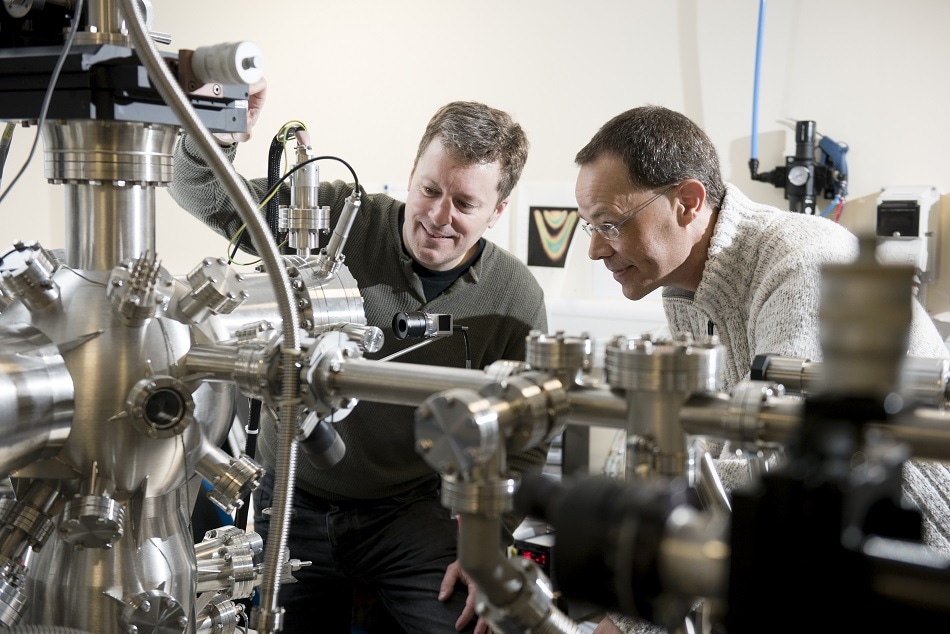 Dr Gavin Bell and Dr Yorck Ramachers in the laboratory, credit University of Warwick
Dr Gavin Bell and Dr Yorck Ramachers in the laboratory, credit University of Warwick
Revisiting the work of Tesla and Einstein has led to two Warwick scientists developing a unique double-glazed solar power device unlike any existing solar panel. Their work offers fresh opportunities to create more advanced photovoltaics.
The device – invented by Dr Gavin Bell and Dr Yorck Ramachers from the University of Warwick’s Department of Physics – provides a totally new approach to collecting solar energy, and employs a gas rather than a vacuum to transport electrical energy.
The device – inspired by early 20th Century ideas – is essentially a thin double-glazed window. The outer pane is transparent and conducts electricity while the inner pane is coated with a special material which acts as a source of electrons under illumination by sunlight – a so-called photocathode. Just like regular high-quality double-glazing, the two panes are separated by a safe, inert gas such as argon.
When sunlight pours down onto the device, electrons are knocked off the photocathode (the inner pane) and bounce through the gas to the outer pane without being lost or absorbed. This is completely different to how electrons behave in existing solar panels and opens up the possibility for improving solar power generation methods. In contrast, ways to improve classic photovoltaics are few and far between.
The electrons are then collected and electrical energy pumped into the grid through a gas-filled gap rather than a vacuum, which would be far more cost-effective for any practical device.
Dr Ramachers and Dr Bell – both Readers in the Department of Physics - revisited ideas about the photoelectric effect dating back to Nikola Tesla and Albert Einstein to consider whether these concepts could be used for solar power generation today.
“The notion of using photoemission to generate power perhaps dates back to Nikola Tesla's patent describing a 'Method of Utilizing Radiant Energy' (US Patent 685958),” the duo write in their paper in Joule. “This was granted in 1901, actually prior to Einstein's famous discussion of the photoelectric effect in terms of light quanta and the work function of a metal cathode. Photocathode photovoltaic (photoelectric solar power) devices, which usually involve transport of charge from the photocathode to an anode through a vacuum, have appeared in the patent literature since the 1960s, but the idea has remained on the periphery of photovoltaics research and development.”
Reconsidering such work has led to the pair developing their new process, and Dr Bell commenting, “It’s satisfying to find a new twist on ideas dating back to the start of the 20th century, and as a materials physicist it is fascinating to be looking for materials which would operate in an environment so different to standard photocathodes.”
The optimal material for the photosensitive layer on the inner pane still needs to be determined, and the scientists are considering a range of candidate materials. One such material under investigation is diamond, thin films of which would be very robust and long-lasting.
The scientists are calling on the wider scientific community to wrack their brains for potential optimal materials:
We think the materials challenge is really critical here so we wanted to encourage the materials science community to get creative. Our device is radically different from standard photovoltaics, and can even be adapted for other green technologies such as turning heat directly into electricity, so we hope this work will inspire new advances.
Dr Gavin Bell, Department of Physics, The University of Warwick
Future work may consider the transparency of the photocathode, which might be varied leading to the possibility of tinted windows generating solar power; photocathodes operating at high pressure, and the driver of photoelectric solar power and other energy-related applications.
Disclaimer: The views expressed here are those of the author expressed in their private capacity and do not necessarily represent the views of AZoM.com Limited T/A AZoNetwork the owner and operator of this website. This disclaimer forms part of the Terms and conditions of use of this website.